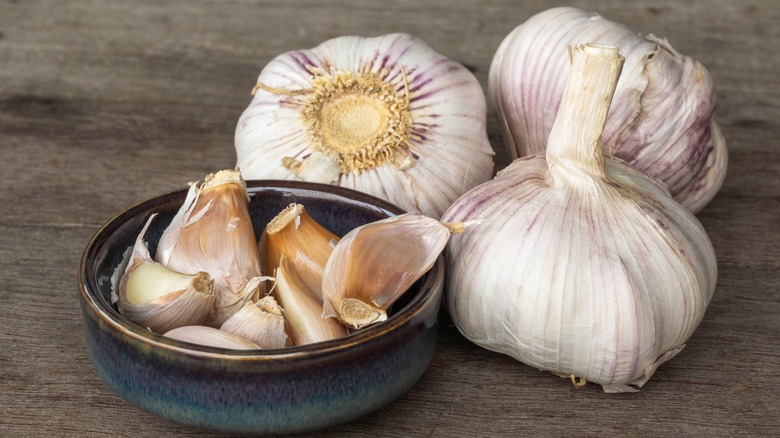How To Prevent Garlic From Turning That Odd Green Color
Garlic is a versatile, popular ingredient that is used in many different dishes, from pasta sauces and soups to roasted meats and vegetables. It is also believed to have several health benefits, including anti-inflammatory and antioxidant properties. Cutting garlic is fairly simple, and so is cooking it, but both of those processes can turn garlic green. This pigment change is due to a natural chemical reaction that occurs in the enzymes present in the garlic.
Allicin is the compound in garlic that is responsible for its characteristic aroma and flavor. Under certain conditions, such as when garlic is cooked in acidic compounds or exposed to high heat for a long time, allicin can break down into a compound called diallyl disulfide. This compound can react with trace amounts of copper in the garlic to produce a bluish-green pigment. If you want to avoid turning your garlic green, there are several things you can do, such as prepping it properly before cooking, changing how and when you cook it, and switching up the ingredients you cook with it.
How to prevent color changes in garlic
To avoid green garlic, you should first store it in a cool, dry place away from sunlight. Exposure to light and moisture can increase the likelihood of discoloration. You can blanche the garlic in boiling water for a few seconds before cooking it, which can inactivate the enzymes responsible for the color change. Additionally, garlic is more likely to turn green when cooked in an acidic environment, so you should avoid adding ingredients like lemon juice or vinegar. You should also avoid cooking onions and garlic together because both contain sulfur compounds. When the two are mixed, the compounds in the onion can react with those in the garlic to form blue or green pigments in the garlic.
Speaking of cooking, garlic is more likely to turn green when cooked for long periods at high temperatures, so you should cook it briefly over low to medium heat. The enzymes responsible for the color change are more active at the beginning of the cooking process, so adding garlic toward the end can help prevent it from turning green.
Using green-colored garlic
While the green color is not harmful, it can indicate that the garlic has been overcooked and may be bitter. If you notice that your garlic has turned green, taste it to determine if the flavor has been affected. If it is too bitter, you can try to calm the flavor with a bit of sugar, a squeeze of lemon juice, or a splash of vinegar. If that doesn't work, it may be best to throw it out and use fresh garlic. If the flavor is not affected, or if you don't mind a more bitter flavor, the garlic can still be used, or you can simply use less of it in your recipe.
It's important to note that garlic that has turned green due to cooking or chopping is not the same as naturally green garlic, which is young garlic that has not yet developed a full bulb. This type of green garlic is harvested early before the plant has had a chance to fully mature, and it is characterized by its long, slender green leaves and a small, white bulb. This garlic tends to be milder and sweeter and is often compared to a cross between garlic and green onion or scallion.


